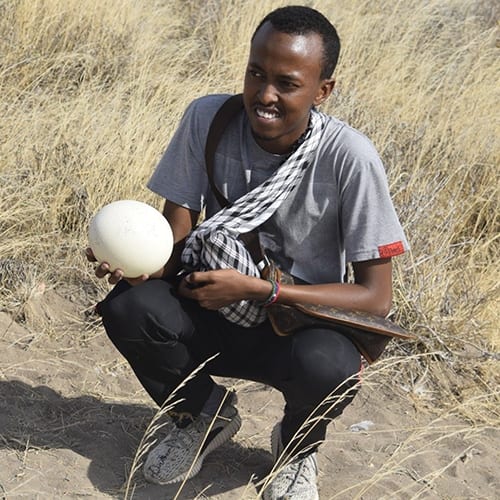Voices From the Rainforest: Hassan Issa, Conservation Fellow
Rainforest Trust projects thrive thanks to the important conservation work of people on the ground. Our Voices from the Rainforest series brings you news from our projects in Latin America, Africa, Asia and the Pacific — from the perspectives of those working in and for the rainforests.

Calling Protected Areas Home
Hassan Issa is a wildlife and environmental enthusiast working as field assistant for Hirola Conservation Program (HCP) within the Bura East Conservancy in Kenya. Hassan is motivated by field-based conservation and is particularly interested in finding solutions that improve human-wildlife relations. He is particularly keen on saving endangered species such as the Hirola, Reticulated Giraffes and Grevy’s Zebra.
Hassan has an excellent understanding of the local environment and communities as he hails from the larger Garissa County. This has enhanced his capabilities and motivation to work with wildlife and the local community. One of his passions is photographing wildlife, which he says is one of the most effective ways of telling wildlife stories.

Hassan in the field. Photo by Hirola Conservation Program.
Why did you become a conservationist?
It is actually a coincidence because I had originally set out to be a humanitarian worker and a peace ambassador. This was informed by the unfortunate violent extremism that was affecting my home area and the neighboring counties. After graduating high school, I chose to study Development Studies for my undergraduate program. When I completed my coursework in 2017 I had to look for an internship, that is where I met with Dr. Abdullahi Ali who was the mentor I needed. He introduced me to conservation.
After going to the field and interacting with wildlife and seeing the positive impact it had on the society, I immediately knew it was the career path I wanted to take. I was impressed by the impact the HCP and their international partners had on our poor rural society. This inspired me to see the bigger picture of conservation. In turn, I now mentor several younger rangers that I have recruited to be future leaders of conservation for our region.
What inspires you most about being a Conservation Fellow?
The most inspiring thing is the fact that I know there are young people out there who are like-minded and are working on the same goal: to protect endangered wildlife and the environment. Robert Swan, the first person in history to walk to both the North and South Poles once said “the greatest threat to our planet is the belief that someone else will save it,” so I am inspired by my colleagues’ work to make this planet a better place than they found it.
“Conservation is important because it helps in protecting earth’s resources including air, water, soil and living things from exploitative human impacts. Conservation will ensure these resources benefit the current and future generations to come.”
Tell us about a time that you felt you had made a difference as a conservationist.
In October 2018, we started implementing the second phase of the Hirola habitat restoration program at the Ishaqbini Conservancy and the Bura East Conservancy. We planted different species of grasses such as Cenchrus ciliaris, Eragrostis superba and Enteropogon macrostachyus, which we identified would do best in that environment and also have significant nutritional values for Hirola.
I was in charge of the field operations. I established grass islands where we worked together with over 50 local people to get rid of Acacia reficiens, an invasive species that makes it hard for native grass to grow. Over a period of 40 days, we planted the grasses on 60-acre plots in each conservancy. I feel like this is my greatest achievement as a conservationist to date because I have not only changed the face of the landscape, but I have also improved the habitat for Hirola and other wildlife species in the sense that there will be an abundance of pasture in the area.
Tell us about a conservation challenge in your job.
One of the major challenges we face is poaching, especially for giraffes. The poachers mainly use wire snares which they attach to trees in the hopes that it sticks in the giraffe’s neck or foot. We have been able to rescue a good number by collaborating with mobile veterinary units from Kenya Wildlife Service.
“Leaving my family and friends at home and going to live in the wilderness is the hardest part for me, although ironically, there is nothing I enjoy more than sleeping in the open sky night while staring at the stars and waking up to the chirping of the birds.”
Tell us about a conservation success.
A conservation success story for the organization is the increased protection of Hirola habitat by establishing new conservancies and subsequently the gradual recovery of the Hirola population. This has brought pride to the neighboring community which has seen the media attention and created renewed interest for conservation by the County Government of Gaissa.
Another success story is definitely the reduced number of poaching incidents that we have witnessed over the past two years. This has been possible because of increased patrols and our recent campaign of educating the community that lives around the conservancy. More importantly, our team also documented new populations of poorly understood populations of endangered mammals, such as African wild dogs, Haggard’s Oribi and Grevy’s Zebra.
Header image: Critically Endangered Hirola. Photo by Hirola Conservation Program.





